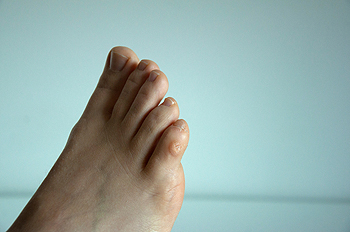 Running is a great sport that can help to build bone density, improve heart health, maintain a healthy weight, and even boost your mood. However, running has one main drawback – it can increase your risk of developing various foot and ankle injuries. Most running injuries are caused by overuse, when excessive pressure is placed on the feet repetitively, damaging the muscles, ligaments, tendons, joints, or bones that make running possible. The risk of injury can be reduced by following something known as the 10% Rule. This simple rule states that if you are increasing the amount of miles you run, you should increase this number gradually, by no more than 10% each week. For example, if you ran 15 miles this week and would like to run even more next week, you should only add 1.5 miles to your mileage total. That is, the following week, you should run no more than 16.5 miles. Increasing your mileage gradually allows your body to get used to the higher demands being placed on it and makes overuse injuries less likely. For more information about preventing running injuries, please consult with a podiatrist.
Running is a great sport that can help to build bone density, improve heart health, maintain a healthy weight, and even boost your mood. However, running has one main drawback – it can increase your risk of developing various foot and ankle injuries. Most running injuries are caused by overuse, when excessive pressure is placed on the feet repetitively, damaging the muscles, ligaments, tendons, joints, or bones that make running possible. The risk of injury can be reduced by following something known as the 10% Rule. This simple rule states that if you are increasing the amount of miles you run, you should increase this number gradually, by no more than 10% each week. For example, if you ran 15 miles this week and would like to run even more next week, you should only add 1.5 miles to your mileage total. That is, the following week, you should run no more than 16.5 miles. Increasing your mileage gradually allows your body to get used to the higher demands being placed on it and makes overuse injuries less likely. For more information about preventing running injuries, please consult with a podiatrist.
All runners should take extra precaution when trying to avoid injury. If you have any concerns about your feet, contact Dr. Richard DiMario of Maine. Our doctor will treat your foot and ankle needs.
How to Prevent Running Injuries
There are a lot of mistakes a runner can make prior to a workout that can induce injury. A lot of athletes tend to overstretch before running, instead of saving those workouts for a post-run routine. Deep lunges and hand-to-toe hamstring pulls should be performed after a workout instead of during a warmup. Another common mistake is jumping into an intense routine before your body is physically prepared for it. You should try to ease your way into long-distance running instead of forcing yourself to rush into it.
More Tips for Preventing Injury
If you have any questions, please feel free to contact our office located in York, ME . We offer the newest diagnostic and treatment technologies for all your foot care needs.
 A corn is a hard, yellowed bump or lump just under the skin of the toe or foot. It often develops when the toe rubs against the inside of your shoe, causing pain. People with diabetes or poor circulation may be more apt to develop corns. There are several treatments that can remove or eliminate corns, but if the underlying cause is not corrected, they are likely to recur. Pressure and repetitive friction are the main causes of corns and calluses on the feet. Wearing shoes that are not too tight, or too loose, can help reduce the pressure on the toes. When shoes are too tight or heels too high they can compress the foot; when they are too loose, the foot may slide and rub against them. A seam or stitching on the shoe also can cause repetitive friction. The best way to avoid corns is to wear shoes with room in the toe box, and socks that absorb moisture. Soaking the feet periodically helps soften the corns. For removal of a corn, it is suggested that you make an appointment with a podiatrist for safe treatment and prevention planning.
A corn is a hard, yellowed bump or lump just under the skin of the toe or foot. It often develops when the toe rubs against the inside of your shoe, causing pain. People with diabetes or poor circulation may be more apt to develop corns. There are several treatments that can remove or eliminate corns, but if the underlying cause is not corrected, they are likely to recur. Pressure and repetitive friction are the main causes of corns and calluses on the feet. Wearing shoes that are not too tight, or too loose, can help reduce the pressure on the toes. When shoes are too tight or heels too high they can compress the foot; when they are too loose, the foot may slide and rub against them. A seam or stitching on the shoe also can cause repetitive friction. The best way to avoid corns is to wear shoes with room in the toe box, and socks that absorb moisture. Soaking the feet periodically helps soften the corns. For removal of a corn, it is suggested that you make an appointment with a podiatrist for safe treatment and prevention planning.
Corns can make walking very painful and should be treated immediately. If you have questions regarding your feet and ankles, contact Dr. Richard DiMario of Maine. Our doctor will treat your foot and ankle needs.
Corns: What Are They? And How Do You Get Rid of Them?
Corns are thickened areas on the skin that can become painful. They are caused by excessive pressure and friction on the skin. Corns press into the deeper layers of the skin and are usually round in shape.
Ways to Prevent Corns
There are many ways to get rid of painful corns such as:
Treating Corns
Although most corns slowly disappear when the friction or pressure stops, this isn’t always the case. Consult with your podiatrist to determine the best treatment option for your case of corns.
If you have any questions please feel free to contact our office located in York, ME . We offer the newest diagnostic and treatment technologies for all your foot and ankle needs.
 Having shoes that fit correctly when hiking is very important because of the stress that is put on your feet. It is important to make sure that the hiking shoes are snug, but not too tight, and that the toes have room to wiggle. There are a few things that can be done in order to make sure hiking boots fit correctly when purchasing them. Because your feet tend to swell during the day, it’s a good idea to try on shoes either toward the end of the day or right after you exercise. Wearing the same socks and orthotics that will be worn with the shoes while hiking is also key in order to make sure you understand how the shoes will fit under those conditions. Shoes should also have a proper width to give the toes enough space, and there should also be enough space between the edge of the toes and the edge of the shoe. If you are unsure that your shoes fit properly, it’s suggested that you consult with a podiatrist who can examine your feet and offer expert advice.
Having shoes that fit correctly when hiking is very important because of the stress that is put on your feet. It is important to make sure that the hiking shoes are snug, but not too tight, and that the toes have room to wiggle. There are a few things that can be done in order to make sure hiking boots fit correctly when purchasing them. Because your feet tend to swell during the day, it’s a good idea to try on shoes either toward the end of the day or right after you exercise. Wearing the same socks and orthotics that will be worn with the shoes while hiking is also key in order to make sure you understand how the shoes will fit under those conditions. Shoes should also have a proper width to give the toes enough space, and there should also be enough space between the edge of the toes and the edge of the shoe. If you are unsure that your shoes fit properly, it’s suggested that you consult with a podiatrist who can examine your feet and offer expert advice.
It is important to find shoes that fit you properly in order to avoid a variety of different foot problems. For more information about treatment, contact Dr. Richard DiMario from Maine. Our doctor will treat your foot and ankle needs.
Proper Shoe Fitting
Shoes have many different functions. They cushion our body weight, protect our feet, and allow us to safely play sports. You should always make sure that the shoes you wear fit you properly in order to avoid injuries and deformities such as: bunions, corns, calluses, hammertoes, plantar fasciitis, stress fractures, and more. It is important to note that although a certain pair of shoes might be a great fit for someone else, that doesn’t mean they will be a great fit for you. This is why you should always try on shoes before buying them to make sure they are worth the investment. Typically, shoes need to be replaced ever six months to one year of regular use.
Tips for Proper Shoe Fitting
The shoes you buy should always feel as good as they look. Shoes that fit properly will last longer, feel better, and improve your way of life each day.
If you have any questions, please feel free to contact our office located in York, ME . We offer the newest diagnostic and treatment technologies for all your foot care needs.
If you are middle-aged, overweight, pregnant, stand for long periods of time, or wear shoes that offer little cushioning, you may be a candidate for plantar fasciitis. Other causes include, having flat feet, wearing ill-fitting shoes, running or jumping on hard surfaces, and having medical conditions, such as diabetes and arthritis. The plantar fascia is a band of tissue that connects the toes with the heels. When the plantar fascia is overstretched or bruised, the heel often bears the brunt of the pain. The pain is usually worse when you first get up in the morning, or after sitting or standing for long periods of time. There are a number of home remedies, such as icing the painful area, massaging your foot by rolling a golf ball under it, losing weight, and wearing heel pads in your shoes. However, if pain continues to increase, it may be wise to seek the opinion of a podiatrist who can examine the area, properly diagnose the condition, and suggest specific treatment options.
Plantar fasciitis is a common foot condition that is often caused by a strain injury. If you are experiencing heel pain or symptoms of plantar fasciitis, contact Dr. Richard DiMario from Maine. Our doctor can provide the care you need to keep you pain-free and on your feet.
What Is Plantar Fasciitis?
Plantar fasciitis is one of the most common causes of heel pain. The plantar fascia is a ligament that connects your heel to the front of your foot. When this ligament becomes inflamed, plantar fasciitis is the result. If you have plantar fasciitis you will have a stabbing pain that usually occurs with your first steps in the morning. As the day progresses and you walk around more, this pain will start to disappear, but it will return after long periods of standing or sitting.
What Causes Plantar Fasciitis?
There are some risk factors that may make you more likely to develop plantar fasciitis compared to others. The condition most commonly affects adults between the ages of 40 and 60. It also tends to affect people who are obese because the extra pounds result in extra stress being placed on the plantar fascia.
Prevention
There are a variety of treatment options available for plantar fasciitis along with the pain that accompanies it. Additionally, physical therapy is a very important component in the treatment process. It is important that you meet with your podiatrist to determine which treatment option is best for you.
If you have any questions, please feel free to contact our office located in York, ME . We offer the newest diagnostic and treatment technologies for all your foot care needs.